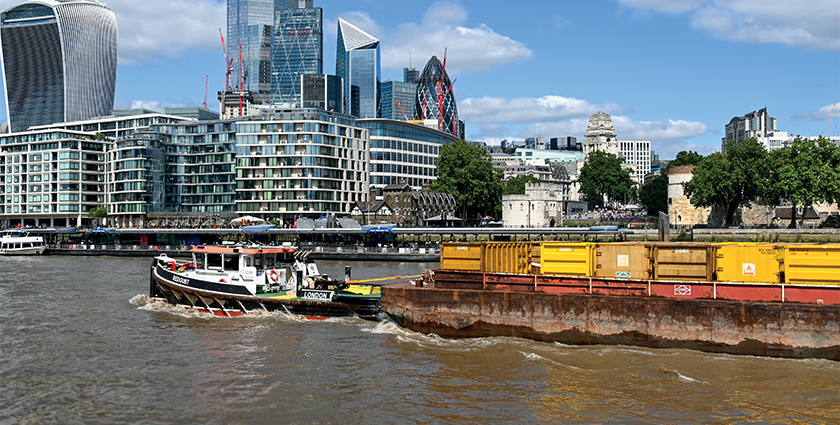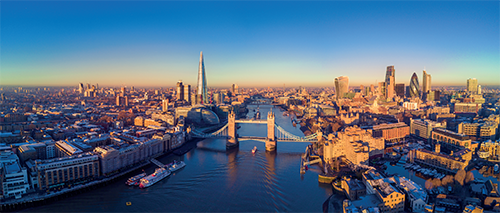
Head to the water
With an estimated 700 million parcels currently delivered annually in London, the potential for handling light freight on the River Thames provides a unique opportunity to rethink the logistics of goods transportation.
There is a fast-growing desire across public and private sector organisations to transport light freight, alongside the heavier freight already moved on the river, to secure environment and logistical benefits. Making better use of the river could significantly contribute to net zero ambitions. It could also help improve air quality.
Every 1,000-ton barge of goods transported along the river removes the need for roughly 100 trips made by lorry cutting congestion. There are clear benefits to shifting light freight from road to river including slashing non-exhaust PMx emissions (generated through breakdown of brakes, clutches, tyres and road surfaces) which are a significant contributor to poor air quality, especially in central London and across UK cities.
In their action plan, ‘The Green Blue’, the Thames Estuary Growth Board set out an objective of delivering the world’s greenest, most productive Estuary. A key part of this is to explore how the River Thames can be better used for freight and it is the commitment of the Thames Estuary Growth Board that will ensure river freight is a viable competitive alternative to road transportation.
There is a growing body of evidence and guidance supporting movement of freight from roads on to rivers and inland waterways. This includes a ‘Light Freight: Design Solutions for Thames Freight Infrastructure’ study co-commissioned by the Thames Estuary Growth Board, the Port of London Authority (PLA) and Cross River Partnership (CRP), that considers the design of the existing piers along the River Thames and how they could be modified to accommodate the requirements of a light freight service.
A suite of design solutions demonstrate how a shortlist of prime pier locations along the Thames could be modified to support light freight as either a partial or continuous service in addition to the potential construction costs involved. The study highlights that while a partial service may be more financially viable to begin with, the volume of cargo would be limited. Whereas a continuous service would require more significant investment but would support a larger operation.
 A future-proof vision of safe, sustainable and predictable movement of large-scale light freight in a city that is notoriously difficult for making deliveries is currently being mapped out to realise this. A report published by Thames Estuary Growth Board in partnership with the PLA ‘Light Freight on the River Thames’, prepared by WSP, clearly defines what a commercially viable river freight solution might look like, alongside a well costed business case.
A future-proof vision of safe, sustainable and predictable movement of large-scale light freight in a city that is notoriously difficult for making deliveries is currently being mapped out to realise this. A report published by Thames Estuary Growth Board in partnership with the PLA ‘Light Freight on the River Thames’, prepared by WSP, clearly defines what a commercially viable river freight solution might look like, alongside a well costed business case.
A precedent for this has already been set with multiple trials on the river including Guys and St Thomas NHS Trust / CEVA / Livetts, and DHL. DHL in particular is exploring this potential for expansion after a positive trial.
Ben Hiles, Senior Director for Engineering and Infrastructure, DHL Express UK said: “Our river boat has an impressive 98 percent journey time reliability, which is a huge asset given the time definite service we offer our customers. We are already moving 50,000 parcels a year using this mode and continue to explore opportunities to further expand the project.”
The co-location programme, which is bringing together historic markets of Smithfield, Billingsgate and New Spitalfields to a purpose-built site at East London’s Dagenham Dock is also looking at using the Thames. This mode of moving freight to and from the markets is cleaner, greener and efficient and importantly, instrumental in helping to reduce the capital’s carbon footprint.
Aside from lack of awareness that waterborne freight is an option, the determining factor for many businesses is cost. However, while the cost may be seen as a barrier for short term and low-scale uses, a long-term look at light freight reveals substantial economies of scale. And many businesses appreciate the reliability of a service unimpeded by congestion and roadworks.
The wider environmental and social benefits are recognised as significant and potential users can unlock subsidies or incentives, including the Government’s Mode Shift Revenue Support (MSRS) scheme. The MSRS was developed with the aim of enabling modal shift away from road transport, but applications from parties interested in waterborne freight have been extremely low.
In response to this, Thames Estuary Growth Board and PLA recently published The ‘Mode Shift Revenue Support (MSRS) – Light Freight Analysis Report’, which provides a succinct evidence base that informs the case for reforming the MSRS scheme to better support the shift to water. The report considers both light and heavy freight, the different needs of river and maritime services, and highlights a number of barriers as well as enablers, including focussing on net zero (such as environmental reporting), technology and innovation.
Four simple changes can make the scheme more effective, according to the report by consultants, WSP. They recommend adjusting the scheme: taking account of the additional barriers faced by waterborne operators; encouraging innovation, particularly in light freight; developing pilot studies to test alternative modes for specific cargo types; and allowing grant funding for capital expenditure in setting-up new operations, rather than just operating costs.
Perry Glading, Deputy Chair of the Thames Estuary Growth Board said: “We’re now inviting businesses to come to talk to us. The fundamentals are there, now it is a matter of getting the supply chain linked up and operational to deliver the volume that will make waterborne freight a commercially sound option. There is no wrong door and the Thames Estuary Growth Board, together with partners including the PLA, Logistics UK and CRP can help connect different businesses interested in participating in this ecosystem and exploring the possibilities light freight can offer. Together we will get the dialogue on what is possible moving at a faster pace with all interested stakeholders, including the DfT, and then turning that into a real shift from road to water.”
With investment and development opportunities to make piers, wharves and river vessels fit for purpose – essential in handling large scale river freight – now is an exciting time to be involved in moving goods on the Thames.
For a list of the sources used in this article, please contact the editor

To find out more about light freight in the Thames Estuary and connect with the Thames Estuary Growth Board, visit thamesestuary.org.uk or to join the conversation and be part of the light freight economy in the Estuary contact enquiries@thamesestuary.org.uk.
Find out more about the PLA (pla.co.uk) Logistics UK (logistics.org.uk) and CRP (crossriverpartnership.org).
We’re in a good place for greener freight. Join us.